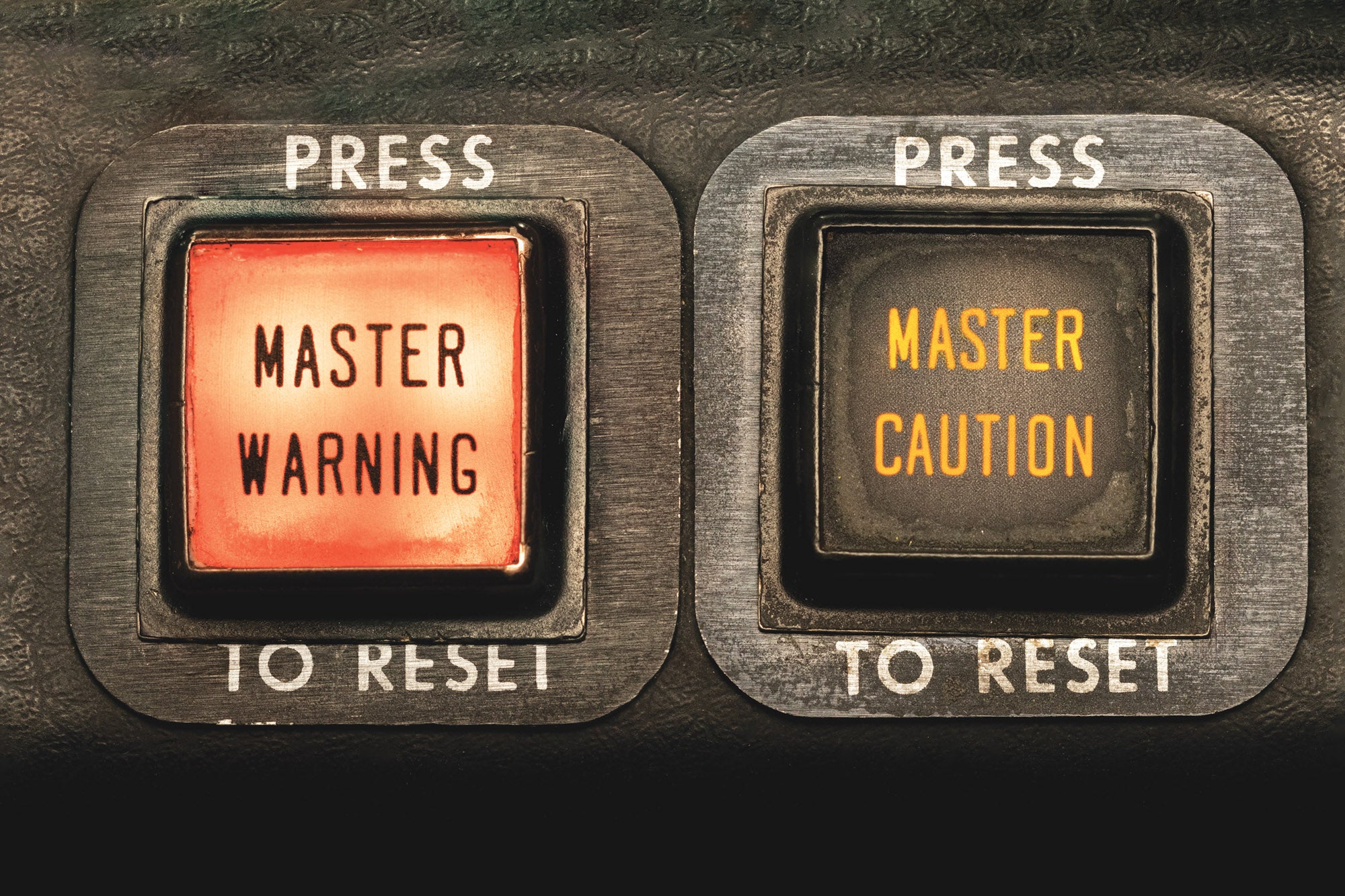
My original intent for this month’s treatise was to produce the first installment of my upcoming Kitfox build series, which I have been greatly looking forward to. However, as often happens in life, life itself got in the way.
Every aircraft I have ever flown has had some form of alert system to advise an operator that there is something to be concerned about. Most aircraft also have a unique aura about them of sound, feel or vibration that can also alert us that something isn’t just right.
As our aircraft are a collection of various systems working together, so are our human bodies. Like aircraft, our bodies have their own alert systems and even electronic interfaces to alert and diagnose problems. We need to keep vigilant in monitoring the warning signs when our aircraft or our bodies start warning us.
A note before I go further: I am not a medical provider, and nothing in this article should be taken as medical education or advice. I share this experience in the hopes that I might place a marker in the back of someone’s mind to act quickly and aggressively to seek proper medical attention if ever faced with a similar situation.
The Event
Last Thursday night, I went to bed at the normal time and was blissfully asleep until 2:02 a.m., awakened by strong pain in the right side of my chest. The matter was further complicated by shortness of breath. I couldn’t take more than about a half-deep breath without difficulty and pain. The first thought for someone old enough for a Medicare card was that chest pain and shortness of breath were not good things. After being immersed in aviation for almost 50 years, my first thoughts on the matter were that I didn’t want to lose my medical or have to jump through a bunch of hoops over something silly.
This issue didn’t feel cardiac-related to me, though I’ve never had a cardiac issue to compare with—other than as a child watching my father die of a heart attack at a considerably younger age than I am now. I first checked the ECG app on my Apple watch and it showed normal. I then repeated the process with my Kardia pad and it showed normal as well. I briefly thought about awakening my wife and having her take me to the emergency room, but by now the pain was starting to subside and I was breathing with less difficulty. I made a decision to just try and go back to sleep. A decision that in hindsight was stupid and could have easily been fatal.
The next morning I awoke with discomfort, but far less than I had endured in the middle of the night. I ran a couple of errands in the morning but was feeling quite run-down. I came home and decided to take a nap. About 30 minutes into my nap, I awoke to severe pain in my chest and difficulty breathing. I knew then that I had to bite the bullet and go to the ER without delay.
Walking into the hospital, I was feeling the worst I had throughout the entire experience. The pain would come in waves. I couldn’t sit upright in a chair. When the young man at the admin desk asked me to describe the pain from a factor of one to 10, my inner smartass asked him if he had ever seen the movie This Is Spinal Tap. He hadn’t, so I decided to not describe the pain as an 11.
The ER was slammed so it took a while to be seen. They started treating me in the hallway because they didn’t have a room available yet. They hooked me up for a full EKG and to my great relief, that showed normal. They took some blood for lab tests and started an IV for some pain medication. That brought relief, but not peace of mind.
Next they took me to radiology for a chest X-ray, which they said showed some concern in my right lung but was otherwise inconclusive. They started mentioning things like a hiatal hernia or a kidney stone. Finally, they decided to do one more blood test, called a D-dimer test. That tests for a protein fragment that the body makes when a blood clot dissolves. They said that this test would rule out pulmonary embolism (PE), which they didn’t anticipate but wanted to rule out before discharging me.
Here is a medical dictionary definition of a pulmonary embolism taken from the Mayo Clinic Family Health Book. “A pulmonary embolism is a blood clot that blocks and stops blood flow to an artery in the lung. In most cases, the blood clot starts in a deep vein in the leg and travels to the lung. Rarely, the clot forms in a vein in another part of the body. When a blood clot forms in one or more of the deep veins in the body, it’s called a deep vein thrombosis (DVT).
“Because one or more clots block blood flow to the lungs, pulmonary embolism can be life-threatening. However, prompt treatment greatly reduces the risk of death.”
After a nerve-racking 45 minutes or so waiting for those results to come back, they came in and said that the test came back “elevated,” meaning that there could be the possibility of PEs, so they then scheduled a CT scan for a final determination. The D-dimer test may have saved my life.
Because of a trauma rush at the ER, it took a while to get the CT accomplished and get it read by the radiology department. That was frustrating, but there was nothing I could do about it. Finally, after several hours in the ER, they ran into my room like the world was on fire. Suddenly wait, wait, wait, became hurry, hurry, hurry. They said that the CT confirmed that I had multiple PEs in my right lung and that they were getting me on medication “immediately.” Knowing that there was a definitive issue brought some mental relief, and about 20 minutes after the medication was administered came welcome physical relief.
Next came a flurry of emotions. I was happy to be alive as PEs can, and often are, fatal or at least stroke-inducing. As someone who likes having an understanding of the “systems,” I was relieved that a definitive diagnosis had been discovered, especially one that can be quickly resolved with blood thinners. My fear was being sent home without a diagnosis while knowing that something was wrong. In a way, I was lucky and blessed; however, I shudder to think what could have happened if I had decided not to come to the hospital and am upset with myself for not coming in earlier at the first indication.

FAA Issues and the Future
The bad news about this whole experience from an FAA perspective is that I am, for the time being, grounded. The good news is that there is a clear pathway forward to obtain a special issuance medical to be able to reobtain my medical and fly again. My treatment plan involves therapy with the blood thinner drug Eliquis; the FAA appears to be fine with Eliquis once the stabilization process and initial monitoring are complete.
I need to be referred to a hematologist for further blood work. That will likely determine whether I will need to be on the blood thinners for just a few months or for the rest of my life. I also need to be monitored by my primary care physician for a minimum of four weeks; he’ll then prepare a report. I will then need to have a pulmonary function test and then submit all of the records of the hospital visit and the like along with reports from my PCP and my aviation medical examiner. My AME (who is also a pulmonologist) is confident and optimistic that we will be successful. Therefore, so am I.
After talking with all of the medical providers involved along with my PCP and my AME, one common thread is that this event could have been tragic. A medical assistant even mentioned to me that they had a patient die in the waiting room from a PE. I have been told that if I ever feel the symptoms again that I need to immediately go to a hospital.
From my first “master caution” alert that something was amiss in my chest until the exact diagnosis was made and lifesaving medications administered, about 21 hours had elapsed. In hindsight, that is unacceptable. Equivalent to me flying around with a broken airplane. Not all of the delay was my fault, but I was reckless to try and disregard the initial symptoms in the hopes that the problem might just go away. Next time, I might not be so lucky.














Excellent article, and applicable to all aspects of life.
Thank you to Myron Nelson for his articulate and concise sharing of this life experience. We should all take note.
Andy Hoffer, P.Eng., PPL
Toronto, Canada
It comes down to what is more important. Is it more important to stay alive or is it more important to try to protect your medical by ignoring (or hiding) a medical condition? If you do not survive a medical event, flying again is not an issue. Glad your PE was not worse.